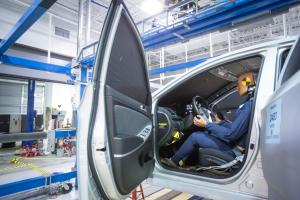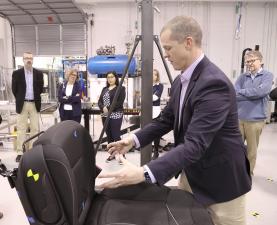Jason R. Kerrigan

About
Jason R. Kerrigan is the Commonwealth Professor of Mechanical and Aerospace Engineering and the Director of UVa's Center for Applied Biomechanics (CAB). The CAB is the largest injury biomechanics research center in the world with more than 50 full-time faculty, staff and students and over $6M in annual research expenditures. They operate out of a dedicated 30,000 sqft facility with a vast array of cutting edge equipment for conducting impact experiments, characterizing biological tissue mechanical properties, performing high-speed imaging and 3D motion capture, designing and fabricating test fixtures, multiscale radiographic imaging, and for storing, preparing, and instrumenting human tissue for biomechanical analyses.
Dr. Kerrigan's research focuses on studying the epidemiology of public health problems related to human injury, characterizing the mechanical response of human tissues, identifying their thresholds for failure (injury), developing and improving mechanical and computational surrogates to study the risks of injury, and exploring countermeasures to mitigate human injury risk and severity. While his research is applied most frequently to automobile safety and the study of occupant protection and vehicle crashworthiness, he has more recently been exploring athlete injury and performance, and how medical devices can replace and affect human musculoskeletal mechanics. His research methods include field data analysis, computational modeling, multiscale characterization and impact experiments. Currently, Dr. Kerrigan has active projects in
-Protecting occupants of highly automated vehicles (HAVs)
-Restraint design for mitigating submarining
-Improving protection for female and obese vehicle occupants
-Injury tolerance and mechanical response of the lumbar spine and pelvis
-Improving injury risk prediction in crash test dummies and human body computational models
-Vehicle design for pedestrian safety
-Predicting injury in non-standard vehicle crash environments, and examining real-world crashes for in-depth analysis
-Shoe-turf interaction mechanics and how they relate to athlete injury and performance
-Cartilage repair
In the past, he has performed extensive research in vehicle-pedestrian and vehicle-cyclist impact, rollover crashes, lower extremity and spinal injuries, sensor-based 3D motion tracking, human musculoskeletal tissue characterization, and some smaller projects in motorsports, off-road vehicles, and human response to pre-crash maneuvers. Overall, Dr. Kerrigan’s research portfolio includes everything from mechanical characterization of human tissues, human body computational modeling, structural crashworthiness design, field data analyses, and crash test dummy development and assessment. Dr. Kerrigan’s work has been supported by industry, government, and academic/research institutions in North America, Europe, and Asia. He has authored three book chapters, over 90 refereed journal articles, and over 130 conference publications. He serves on the International Research Council on the Biomechanics of Injury (IRCOBI), and on the Stapp Association Advisory Committee, and he served as an Associate Editor for Traffic Injury Prevention.
Currently, Prof. Kerrigan teaches Continuum Mechanics at the graduate level, Mechanical Vibrations at both the undergraduate and graduate level, and Strength of Materials for 2nd-year undergraduates in MAE. He serves on the UVa Faculty Senate and the SEAS Faculty Council. He grew up in Reston, Virginia, but now lives in Charlottesville with his wife and two sons.
Education
B.S. Integrated Science and Technology, James Madison University
M.S. Mechanical and Aerospace Engineering, University of Virginia
Ph.D. Mechanical and Aerospace Engineering, University of Virginia

